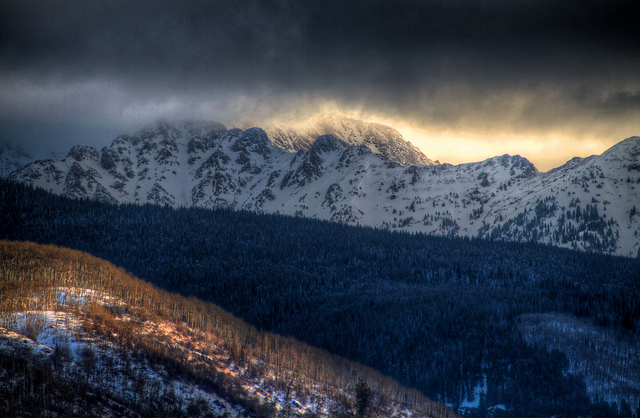In the cold of earliest morning at Pendle Hill Quaker Center, I venture from my room to the Main House, where kitchen lights already shine welcome. The coffee tastes even better than it smells. Slipping back outside a few moments later, I see the trees more clearly, every winter twig outlined by the brightening sky. In this sunshine, the cold seems less bitter.
God gives snow like wool, and scatters frost like ashes.
God hurls down hail like crumbs — who can stand before God’s cold? (Psalm 147:16-17)
God’s cold has come — but in the northern hemisphere’s darkest days, it’s mostly light that shines throughout Scripture and lectionary, comforting those in gloom. Darkness flees into deepest shadow when radiance appears. Those of us living in cool zones benefit from the strange fact that Scripture, composed in a hotter climate, nevertheless loves light and warmth so much. God’s first act of creation on the Bible’s first page is light. Jesus’ presence in the world is imagined as light so bright that darkness cannot overcome it.
Even where light is not directly named, it pervades January’s lectionary. The returning exiles are radiant. Wisdom guides as a starry flame, and God’s voice flashes forth flames of fire. The mystery of God’s will is made known through insight. God’s eyes behold the psalmist’s unborn substance, woven in the earth’s depths. Nathaniel is told to “come and see,” but it is Jesus who sees right through him.
We know the need for dark and cold in the earth’s rhythms. Bulb plants need cold days before they bloom. Creatures need sleep before we wake, and darkness for comfortable slumber. Even nocturnal animals need the dark as cover for their activities. Yet it is the light that awakens and beckons us. It is the light by which we dress, the light through which we find renewal to plan our days.
The ancients long ago recognized the sun’s light and warmth as critical life forces. They used this visible knowledge to imagine God’s invisible power. But today, for people more cognizant of God than of the sun, we have to turn the metaphor back around. Scientists know now, though most of us forget, that the earth’s biosphere is an almost closed system. Apart from the occasional meteor, the only thing entering this system from outside is solar power. It is the source of all earthly energy, whether stored in living plants as food and cell tissue, or sequestered deep in the earth as fossil fuel, or acting in the present moment, moving winds, warming rocks, and enlivening animals.
The sun’s light was once the most convincing metaphor of God’s daily shining on us all. It is still, quite literally, the primary means by which God’s grace reaches us, lending sustenance and wellbeing. So in the cold, in winter darkness, we celebrate all the more the sun’s penetrating light, and encourage gratitude for its power every single day.
January 4
- Jeremiah 31:7-14 envisions those God gathers “radiant over the goodness of the Lord, over the grain, the wine, and the oil,” their lives like a watered garden, never languishing again.
- Sirach 24:1-12 (alt.) describes wisdom coming from the mouth of the Most High, covering the earth like a mist, compassing the vault of heaven and traversing the depths of the abyss.
- Psalm 147:12-20 celebrates God’s blessing: peace, finest wheat, snow, hail, and flowing water.
- Wisdom of Solomon 10:15-21 (alt.) describes Wisdom as the one who led the people across the Red Sea, becoming a shelter by day and a starry flame throughout the night.
- Ephesians 1:3-14 continues the wisdom theme, describing God’s making known “the mystery of his will…as a plan for the fullness of time.”
- John 1:(1-9), 10-18 announces that in the Word, in the beginning with God, “the light shines in the darkness, and the darkness did not overcome it.”
January 11
- Genesis 1:1-5 describes God’s calling light from the darkness that covered the face of the deep, when the earth was a formless void. This light was the first thing God called “good.”
- Psalm 29:1-11 repeated announces “the voice of the Lord,” which thunders over the waters, breaks the cedars, flashes forth flames of fire.
- Acts 19:1-7 relates the coming of the Holy Spirit to believers in Ephesus.
- Mark 1:4-11 shows John the baptizer, drawing people to the wilderness to experience God’s power in the Jordan River.
January 18
- 1 Samuel 3:1-10, (11-20) relates God’s calling Samuel when visions were scarce and Eli the priest’s eyesight was dim, but “the lamp of God had not yet gone out.”
- Psalm 139:1-6, 13-18 celebrates God’s knowledge of the psalmist, saying: “My frame was not hidden from you, when I was being made in secret, intricately woven in the depths of the earth. Your eyes beheld my unformed substance.”
- 1 Corinthians 6:12-20 teaches that the human body is God’s temple.
- John 1:43-51 relates how Jesus saw, and saw through, Nathaniel, and told him what he would see in the future.
January 25
- Jonah 3:1-5, 10 relates the Ninevites’ powerful response to Jonah’s ever-so-brief message, saving them from destruction.
- Psalm 62:5-12 expresses confidence in God as rock and fortress, and not in human wealth.
- 1 Corinthians 7:29-31 reminds that “the appointed time has grown short … for the present form of this world is passing away.”
- Mark 1:14-20 describes Jesus’ reaching out to fisherman on the Sea of Galilee with the good news of God’s reign.

